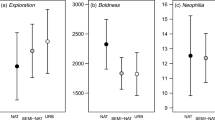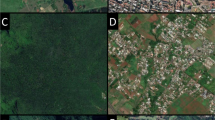Abstract
The effects of urbanization on avian cognition remain poorly understood. Risk-taking behaviors like boldness, neophobia and flight distance are thought to affect opportunism and innovativeness, and should also vary with urbanization. Here, we investigate variation in risk-taking behaviors in the field in an avian assemblage of nine species that forage together in Barbados and for which innovation rate is known from previous work. We predicted that birds from highly urbanized areas would show more risk-taking behavior than conspecifics from less urbanized parts of the island and that the differences would be strongest in the most innovative of the species. Overall, we found that urban birds are bolder, less neophobic and have shorter flight distances than their less urbanized conspecifics. Additionally, we detected between-species differences in the effect of urbanization on flight distance, more innovative species showing smaller differences in flight distance between areas. Our results suggest that, within successful urban colonizers, species differences in innovativeness may affect the way species change their risk-taking behaviors in response to the urban environment.


Similar content being viewed by others
References
Audet JN, Ducatez SD, Lefebvre L (2016) The town bird and the country bird: problem solving and immunocompetence vary with urbanization. Behav Ecol 27:637–644. doi:10.1093/beheco/arv201
Blumstein DT (2003) Flight initiation distance in birds is dependent on intruder starting distance. J Wildl Manage 67:852–857
Blumstein DT (2006) Developing an evolutionary ecology of fear: how life history and natural history traits affect disturbance tolerance in birds. Anim Behav 71:389–399
Chace JF, Walsh JJ (2006) Urban effects on native avifauna: a review. Landsc Urban Plan 74:46–69
Clucas B, Marzluff JM (2015) A cross-continental look at the patterns of avian species diversity and composition across an urbanisation gradient. Wild Res 42:554–562
Ducatez S, Lefebvre L (2014) Patterns of research effort in birds. PLoS ONE 9:e89955
Ducatez S, Audet JN, Lefebvre L (2014) Problem solving and learning in Carib grackles: individuals show a consistent speed-accuracy trade-off. Anim Cogn 18:485–496
Dunning JB (2008) CRC handbook of avian body masses, 2nd edn. CRC Press, Inc, Boca Raton, p 672
Echeverría AI, Vassallo AI (2008) Novelty responses in a bird assemblage inhabiting an urban area. Ethology 114:616–624
Echeverría AI, Vassallo AI, Isacch JP (2006) Experimental analysis of novelty responses in a bird assemblage inhabiting a suburban marsh. Can J Zool 84:974–980
Greenberg R (2003) The role of neophobia and neophilia in the development of innovative behaviour of birds. In: Reader SM, Laland KN (eds) Animal innovation. Oxford University Press, Oxford, pp 175–196
Greenberg R, Mettke-Hofmann C (2001) Ecological aspects of neophobia and neophilia in birds. Curr Ornithol 16:119–178
Griffin AS, Guez D (2014) Innovation and problem solving: a review of common mechanisms. Behav Process 109(Pt B):121–134
Hadfield JD (2010) MCMC methods for multi-response generalized linear mixed models: the MCMCglmm R Package. J Stat Softw 33:1–22. http://www.jstatsoft.org/v33/i02/
Jetz W, Thomas GH, Joy JB, Hartmann K, Mooers AO (2012) The global diversity of birds in space and time. Nature 491:444–448
Kark S, Iwaniuk A, Schalimtzek A, Banker E (2007) Living in the city: can anyone become an “urban exploiter”? J Biogeogr 34:638–651
Lefebvre L, Whittle P, Lascaris E, Finkelstein A (1997) Feeding innovations and forebrain size in birds. Anim Behav 53:549–560
Lefebvre L, Gaxiola A, Dawson S, Timmermans S, Rosza L, Kabai P (1998) Feeding innovations and forebrain size in Australasian birds. Behaviour 135:1077–1097
Lefebvre L, Ducatez S, Audet JN (2016) Feeding innovations in a nested phylogeny of neotropical passerines. Philos Trans R Soc B 371:20150188
López-Sepulcre A, Kokko H (2012) Understanding behavioural responses and their consequences. In: Candolin U, Wong BBM (eds) Behavioural responses to a changing world. Oxford University Press, Oxford, pp 3–12
Maklakov AA, Immler S, Gonzalez-Voyer A, Ronn J, Kolm N (2011) Brains and the city: big-brained passerine birds succeed in urban environments. Biol Lett 7:730–732
McKinney ML (2002) Urbanization, biodiversity and conservation. Bioscience 52:883–890
Meffert PJ, Dziock F (2013) The influence of urbanisation on diversity and trait composition of birds. Land Ecol 28:943–957
Møller AP (2008a) Flight distance and blood parasites in birds. Behav Ecol 19:1305–1313
Møller AP (2008b) Flight distance of urban birds, predation and selection for urban life. Behav Ecol Sociobiol 63:63–75
Møller AP (2008c) Flight distance and population trends in European breeding birds. Behav Ecol 19:1095–1102
Møller AP (2009) Successful city dwellers: a comparative study of the ecological characteristics of urban birds in the Western Palearctic. Oecologia 159:849–858
Møller AP (2010) Interspecific variation in fear responses predicts urbanization in birds. Behav Ecol 21:365–371
Morand-Ferron J, Lefebvre L (2007) Flexible expression of a food-processing behaviour: determinants of dunking rates in wild Carib grackles of Barbados. Behav Process 76:218–221
Mueller JC, Partecke J, Hatchwell BJ, Gaston KJ, Evans KL (2013) Candidate gene polymorphisms for behavioural adaptations during urbanization in blackbirds. Mol Ecol 22:3629–3637
Overington SE, Morand-Ferron J, Boogert NJ, Lefebvre L (2009) Technical innovations drive the relationship between innovativeness and residual brain size in birds. Anim Behav 78:1001–1010
Overington SE, Griffin AS, Sol D, Lefebvre L (2011) Are innovative species ecological generalists? A test in North American birds. Behav Ecol 22:1286–1293
R Development Core Team (2008) R: A language and environment for statistical computing. R Foundation for Statistical Computing, Vienna, Austria. ISBN 3-900051-07-0. http://www.R-project.org
Réale D, Reader SM, Sol D, McDougall PT, Dingemanse NJ (2007) Integrating animal temperament within ecology and evolution. Biol Rev 82:291–318
Samia DSM, Nakagawa S, Nomura F, Rangel TF, Blumstein DT (2015a) Increased tolerance to humans among disturbed wildlife. Nat Commun 6:8877. doi:10.1038/ncomms9877
Samia DSM, Møller AP, Blumstein DT (2015b) Brain size as a driver of avian escape strategy. Sci Rep 5:11913
Shochat E, Warren PS, Faeth SHH (2006) Future directions in urban ecology. Trends Ecol Evol 21:661–662
Shochat E, Lerman S, Fernández-Juricic E (2010a) Birds in urban ecosystems: population dynamics, community structure, biodiversity, and conservation. Urban Ecosyst Ecol Agronomy Monogr 47907:75–86
Shochat E, Susannah B, Warren PS, Faeth S (2010b) Invasion, competition and biodiversity loss in urban ecosystems. Bioscience 60:199–208
Sih A, Del Giudice M (2012) Linking behavioural syndromes and cognition: a behavioural ecology perspective. Philos Trans R Soc B 367:2762–2772
Sol D (2015) The evolution of innovativeness: exaptation or specialized adaptation? In: Kaufman A, Kaufman J (eds) Animal creativity and innovation: research and theory. Academic Press, San Diego, California, pp 163–182
Sol D, Duncan RP, Blackburn TM, Cassey P, Lefebvre L (2005) Big brains, enhanced cognition, and response of birds to novel environments. Proc Nat Acad Sci USA 102:5460–5465
Sol D, Maspons J, Vall-Llosera M, Bartomeus I, Garcia-Pena GE, Pinol J, Freckleton RP (2012) Unraveling the life history of successful invaders. Science 337:580–583
Sol D, Lapiedra O, González-Lagos C (2013) Behavioural adjustments for a life in the city. Anim Behav 2013:1101–1112
Sol D, González-Lagos C, Moreira D, Maspons J, Lapiedra O (2014) Urbanisation tolerance and the loss of avian diversity. Ecol Lett 17:942–950
Timmermans S, Lefebvre L, Boire D, Basu P (2000) Relative size of the hyperstriatum ventrale is the best predictor of feeding innovation rate in birds. Brain Behav Evol 56:196–203
Webster SJ, Lefebvre L (2000) Neophobia in the Lesser Antillean bullfinch, a foraging generalist, and the bananaquit, a nectar specialist. Wilson Bull 112:424–427
Webster SJ, Lefebvre L (2001) Problem solving and neophobia in a columbiform-passeriform assemblage in Barbados. Anim Behav 62:23–32
Zuur A, Ieno EN, Walker N, Saveliev AA, Smith GM (2009) Mixed effects models and extensions in ecology with R. Springer, New York
Acknowledgments
SD was funded by postdoctoral fellowships from the Fondation Fyssen (France) and from the Australian Research Council, JNA by Fonds de Recherche Nature et Technologie du Québec and Hydro-Québec doctoral scholarships, LL by a Discovery grant from Natural Sciences and Engineering Research Council Canada, LK by NSERC postgraduate fellowship.
Author information
Authors and Affiliations
Corresponding author
Ethics declarations
Ethical Approval
Research on birds of Barbados is conducted with permission from the McGill University Animal Care Committee (Protocol 2013-7140) and the Natural Heritage Department of the Barbados Ministry of Environment and Drainage.
Additional information
Simon Ducatez and Jean-Nicolas Audet have contributed equally to the study.
This article is part of the Special Issue Animal cognition in a human-dominated world.
Electronic supplementary material
Below is the link to the electronic supplementary material.
Rights and permissions
About this article
Cite this article
Ducatez, S., Audet, JN., Rodriguez, J.R. et al. Innovativeness and the effects of urbanization on risk-taking behaviors in wild Barbados birds. Anim Cogn 20, 33–42 (2017). https://doi.org/10.1007/s10071-016-1007-0
Received:
Revised:
Accepted:
Published:
Issue Date:
DOI: https://doi.org/10.1007/s10071-016-1007-0




